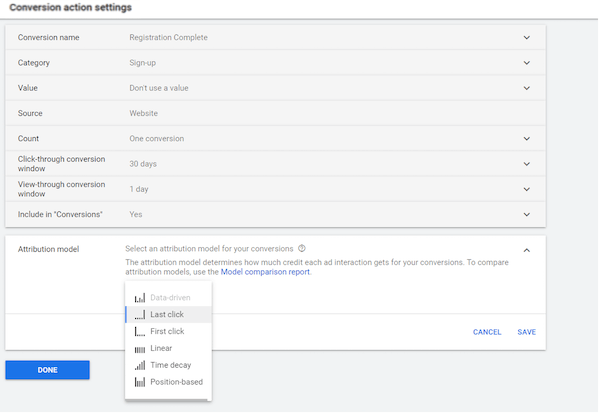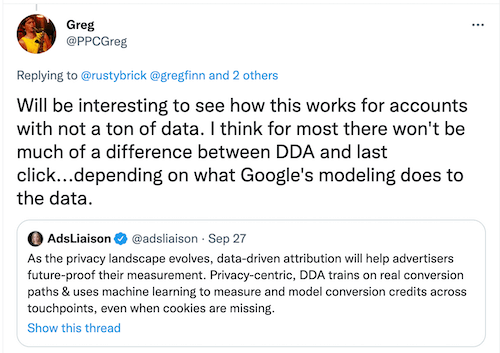* This article was originally published here

Step into the Internet Marketing Blog that reveals real strategies behind viral traffic, smart funnels, and sustainable online growth. Learn top SEO tactics, content hacks, and affiliate tools used by leading marketers. Stay ahead with trend insights, boost engagement, and turn ideas into action. Whether you're starting out or scaling up, this blog delivers nonstop value and inspiration. The roadmap to your breakthrough begins here — dive in now!








When it comes to PPC, there is no one person who knows all the intricacies of every platform like the back of their hand. I’ll admit, as a seasoned Google Ads vet, attribution models has been my weak point in terms of expertise—up until recently.
Google has yet again stirred the pot by releasing changes to default attribution models across accounts. This was the push I needed to take my knowledge in attribution modeling beyond surface level. So I did the dirty work of investigating Google’s latest change to answer all your questions, like:
Read on to find out!
Google announced on September 27 that it is changing the default attribution model for all new conversion actions in Google Ads, from last-click attribution to data-driven attribution (DDA). In addition, it is removing any previously required data minimums for DDA attribution modeling and making it available for more conversion types, including in-app and offline conversions.
In order to fully understand this update, you’ll want to have a solid base knowledge of attribution modeling.
Attribution models help you accurately credit actions that lead to a conversion, helping to remove some of the conversion tracking hangups advertisers face. When someone converts, they may have interacted with multiple different ads over time up until that point. The various attribution models credit each of those moments differently to fit your business needs.
There are six attribution models:

Essentially, while the first five attribution models are “rules-based,” DDA uses your account’s historical data to distribute the credit for a conversion across interactions that may have different weights or impacts onto the overall bottom line. We provide you with more on attribution modeling types and tips here.
Here are a few of the finer details to know about this annoucement.
The change is designed to "future-proof" conversion tracking for all
In its announcement, Google shared that “As the industry continues to evolve, last-click attribution will increasingly fall short of advertisers’ needs.” These changes will make accurate conversion crediting accessible to all types of businesses, all while respecting user privacy. Ginny Marvin, Google Ads Liaison, summarizes this in her tweet below:

You may not see the change right away
While Google did not provide an official date, the change to DDA as the default for new conversion actions will be rolling out over the next few months, starting in October. This means that you might not see the change reflected right away in your account.
There may be changes to your existing conversion actions
Ginny confirmed in the same thread that Google will be switching current last-click attribution actions to DDA “for many advertisers.” It's not clear what "how many" means, but you will get notified “with plenty of warning” and have the opportunity to opt out if you wish to stick with last-click attribution modeling.

Since the original default was last-click and the new is DDA, I thought it would be helpful for you to understand how the two compare and contrast. There are two main ways:
Data-driven attribution can provide more holistic data
In some ways, DDA can give you a more holistic view of your conversion paths. This will help the underdogs of your account shine. Remember, even if the last click from those assets didn’t result in a conversion, their interactions will still show they did at least something for you.
Last click, however, is more rigid, only allowing the ad that brought in the final click to wear the conversion crown.

DDA is less black and white
Second, last click attribution (and first click attribution) only report on complete conversions. These can be easier grasped when analyzing your advertising ROI. Meanwhile, DDA will credit interactions on ad towards a conversion action even if those interactions didn’t directly result in a completed conversion.
For example, a DDA conversion might be reported as 1.5 conversions within the conversions column, while a last click conversion will would just consider it one single conversion.
The above point drives home the fact that DDA looks at various historical data points to know when an interaction is actually meaningful. In contrast, last click reporting is black and white.
Even the most advanced PPC experts can get tripped up when it comes to attribution modeling. I’ll bet there’s plenty of questions popping up with this change, so let’s address a few:
No. Even though DDA will become the default attribution model for all new conversion actions, you can manually switch to any of the five other attribution models if you choose.
While Google said DDR will be the default for new conversion actions, it did say that it will be migrating existing conversion actions “for many advertisers” over to DDA. As mentioned above, it’s unclear exactly which accounts this applies to, but it will be happening over the coming months and you will get plenty of notice.

If Google chooses to switch your existing conversion actions over to DDA, you will get multiple alerts indicating that your actions are about to switch to DDA. Within those notifications you’ll be able to opt out.
It’s easy! In the platform under tools and settings, simply select conversions under measurement. Once there, be sure to customize your columns to include attribution model. Since attribution models can vary from action to action, you’ll get a breakdown of what action is on what model.
You can also change your actions’ attribution models at any time within that same section. Again, under tools and settings, you’ll want to click conversions under measurement. Once there, when you click on any specific conversion action you’ll see a drop down to change its attribution model.

Remember, with certain automated features in Google Ads, data requirements are set in place so that the machine learning has something to go off of.
Julie Bacchini brings up a good point that if DDA previously had a minimum data requirement threshold so that the machine learning could properly function, how can we know that it will work well for accounts below that threshold?

As Ginny reiterates in her response, the update shares that Google has improved its DDA modeling to be able to pick up quicker with less data—allowing it to support lower-data accounts. However, there has yet to be any case studies confirming this.

@PPCGreg also brought this up.
I, too, wonder how much of a difference DDA will make on smaller accounts compared to last click.
However, Ginny’s response focuses more on the fact that DDA is meant to “future proof” measurement, since it uses machine learning rather than cookies, which as we know will be gone next year.

Whether you’re more comfortable with one over the other as your default model is totally your call. It depends on your personal advertising goals, as well as your conversion tracking set up and what makes sense to your business to report on.
If you want Google to help make the call on whether or not certain interactions helped you out in the game of conversions, go for DDA. If you feel the last click to lead to a conversion is the most impactful, stick with last click.
A day laborer is someone who is hired and paid for one day at a time.
There is no promise of future work.
Often, it’s an unskilled position, frequently in agriculture or construction. It can be a tough way to barely eke out a living.
Yet, that’s the position many online business owners have willingly put themselves in.
They may have developed a sellable skill, but they’re surviving one job at a time.
Let’s take a copywriter for example. They develop a valuable skill and start working for clients.
During their first year they may take on multiple jobs where they’re underpaid and underappreciated. They put in their dues while building experience, a portfolio, and a client base.
But if they stay in that same feast-and-famine situation for the next decade, they’re doing it wrong.
Instead, they should establish relationships with several ongoing clients.
Set them up as ongoing monthly retainers…or even better…create profit sharing with one or more of the top clients. That way they can tap into someone else’s business leverage.
Put together books and/or courses for additional streams of income and to provide an ongoing source of new clients.
The monthly retainers or profit sharing may be as far as they want to take the leverage, and that’s OK.
Someone else may transition all the way into a CEO position. As they’re writing copy and building up connections, they also put together systems they follow for each step in the copywriting phase.
They bring in a couple of copywriting cubs to write the initial rough drafts or do the majority of the copywriting in their place.
It’s their choice how far they want to take this.
CEO’s work hard. They may put in more hours than the day laborer, but their income is not limited by the hours they work. Instead, it’s based off the results they achieve through leveraging systems and people to create value for a larger audience.
They’re building something. They’re creating a vision that guides their organization.
They’re putting systems and a team in place to create consistent results for their clients.
Becoming the CEO doesn’t have to mean a large organization. Internet-based businesses run lean.
The ones I’ve worked with frequently have only 1 to 10 employees.
You can hit the million+ level with just one direct assistant along with a few outsourcers. This is made possible by all the tools you can use to automate a majority of the work.
Here’s the question you need to answer for yourself…
Are you the day laborer or the CEO?
Does it feel like you’re stuck in place running on a never-ending treadmill, overwhelmed by everything you have to do each day?
Or are you putting systems in place…using leverage to scale your business while freeing yourself from the day-to-day?
The November issue of the Monthly Mentor Club is about scaling your online business from 6-figures to 7-figures and beyond.
It comes from over a decade of my experience coaching clients one-on-one…including many at 7-figures+.
There are a few core differences in both their mindset and how they set-up their businesses.
You’ll discover what you should focusing on as you make the transition…and the biggest bottlenecks you’ll face as you grow.
Plus, there are a whole lot of tips for those just starting out to build their business the right way from day one.
Click here now to join the Monthly Mentor Club and get the November issue mailed out to you on November 1st.
The October issue of the Monthly Mentor Club will be mailed out to all members tomorrow, October 1st.
It’s called the “Amazon Funnel Formula”.
It’s about generating a consistent, ongoing source of buyers for your products and services.
Amazon is a search engine for buyers.
You need to understand the basics of Amazon’s search engine before you create your book.
Amazon’s primary goal is to sell stuff. Everything they do is directed toward that goal.
They make it easy for a customer to find what they’re looking to buy. They suggest other similar products customers will buy.
If customers are buying your book, Amazon will show it more often.
If no one buys your book, they’ll stop showing it to customers…replacing it with something that earns them more money.
Some of the key factors in your Amazon ‘search engine ranking’ include:
Titles/Subtitles
I recommend the title: subtitle model for your book title.
Make the main title short and memorable.
Use a subtitle to clarify your message and include keyword phrases customers might use to search for you.
Keywords
You get to choose up to 7 keyword phrases of 50 characters each when setting up your book inside KDP.
Use all 7 boxes.
The first few boxes should be your most important keyword phrases. Fill the last few boxes up with less important keyword phrases, using all 50 characters in those.
Description
This is a less important search factor, because you primarily want to speak to your target audience in your book description.
But you can use your most important keywords as ‘triggers’ for your customers that your book is exactly what they’re looking for.
Conversion
Convert viewers into buyers.
You want to appear on relevant keywords that attract buyers for your book.
The better you convert on a keyword; the more likely Amazon will keep showing you on that term.
Who is your buyer and what are they searching?
The “Amazon Funnel Formula” goes into more detail on each of these factors and so much more.
Discover how to attract your ideal buyers, convert them into Amazon book sales, and upgrade them into your other products and services.
Your books can earn passive income. But they’re even more valuable as consistent buyer magnets and authority triggers, increasing the conversion of everything else you sell.
You’ll discover how to come up with an attention-grabbing hook for your book, choose categories and keywords, write clickable titles, write book descriptions that sell, solicit reviews, and launch your book.
Join the Monthly Mentor Club today to get the print copy mailed out to you October 1st.
45 Marketing Ideas for Small Businesses (2026) Shopify * This article was originally published here Start making $300 per day in 10 min...